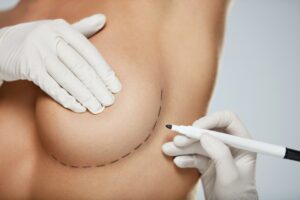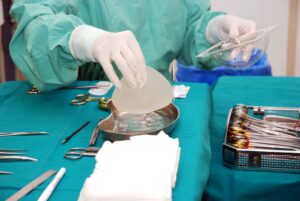Your Breast Implant Placement options – Under the Muscle or Over the Muscle?
Written By Joe Gryskiewicz, MD, FACS
One of the key considerations when having breast implant surgery is implant placement. The implant options you could decide on are submuscular, subglandular, and dual plane. But let’s look at what each involves and how they are helpful.
Minnesota Plastic Surgeons Dr Joe Gryskiewicz can perform the most advanced breast implant surgery and offer a range of implant placement options to help you achieve the look you want. When we do subglandar, we want to be certain the reader realizes this is behind the pec muscle fascia but still on top of the muscle. Dual plane means part under the muscle and part not under muscle.
What Are the Implant Placement Options?
As promised, below are the implant placement options you can choose from when deciding to have breast implant surgery performed. Let’s take them one by one and analyze them.
Submuscular Implant
The submuscular implant (1) goes under the chest muscle. The “submuscular” and “under the muscle” terms are the most accurate. They refer to the surgery of partially placing the implant submuscular.
Submuscular implants feature pectoralis muscle lower attachments. This muscle covers the implant’s upper part, whereas the breast tissue covers the implant’s bottom part.
The benefits of submuscular implants (2) are:
- Allowing the transition between the chest wall and the implant to be smoother
- Providing more coverage for the tissue
- Achieving a result that looks more natural
Subglandular Retromammary Implant
For over-the-muscle or subglandular placement (3), the breast implant goes between the chest muscle and the existing breast tissue areas BUT under the fascia or lining of the pectoral major muscle, for better tissue coverage. This plane or pocket helps to avoid wrinkling. This method ensures the implant is below the gland of the breast.
The best candidates for subglandular implants are women with a B or larger cup who have more breast tissue. Moreover, you can look more rounded and pronounced.
If your cleavage area has more soft tissue, the subglandular impact is your best option. The position of the implant will be between the pectoralis muscle and the overlying breast tissue.
This implant placement avoids animation or movement during physical activities. Moreover, the procedure is more straightforward.
If you undergo a subglandular placement procedure, you may have less discomfort and recover faster after surgery, because your chest muscle will remain undisturbed. What’s also great about this placement is that it doesn’t present too much swelling. BUT remember, we use the Quick Recovery® augmentation regardless of the pocket you chose.
With the breast implant subglandular placement, the breasts settle into their natural shape and form much faster. In addition, when the chest muscle flexes, the implant doesn’t distort in any way. In other words, you will have breasts that look more natural with this type of procedure.
Here are the benefits of undergoing a subglandular placement procedure:
- A more appealing cleavage
- Reduced widening of the cleavage
- Improved shape
- Zero breast animation risk
Dual Plane Implant
![]() For the dual plane implant procedure (4), the implant goes between the pectoralis muscle and the rib cage. Therefore, the breast implant’s upper half is behind the pectoralis muscle. In contrast, the implant’s lower half is behind the breast tissue.
For the dual plane implant procedure (4), the implant goes between the pectoralis muscle and the rib cage. Therefore, the breast implant’s upper half is behind the pectoralis muscle. In contrast, the implant’s lower half is behind the breast tissue.
This implant placement position is ideal for women with little or thin breast tissue. The muscle covers the implant’s upper area, just around the cleavage area. Dual plane implant placement is perfect for correcting ptosis or breast sagging.
Women who had children, breastfed, lost weight, or aged, can opt to undergo this procedure at any moment. In addition, those with saggy breasts can benefit from a lifted appearance because the implant will be lower enough to fill the breast’s bottom pole.
Dual plane breast placement doesn’t eliminate the need to undergo mastopexy or breast lifting when there’s moderate or severe sagginess. However, it does help when cases of saggy breasts are mild.
The dual-plane works for women with low-grade breast droop who want fuller breasts with a less visible scar. It also works for those with tuberous breasts. Tuberous breasts don’t have a natural shape because they didn’t develop properly during puberty. Their cause is a congenital abnormality.
This technique needs more soft tissue for hiding or camouflaging the underlying implants. This type of placement transition takes place more smoothly, and the breast shape improves. In other words, after the procedure, your breasts will look more natural.
What’s also great about dual-plane implant placement is that it poses a lower risk of capsular contracture. Your surgeon or doctor can read mammograms easier as well.
If you undergo this type of breast placement, get ready to recover more slowly and feel increased discomfort. Besides, the results are only temporary, even if it offers long-term benefits. Besides, there might be an increased risk of suffering from animation deformity if you are an athlete, gymnast, or bodybuilder.
When the muscle doesn’t release to the correct degree after the dual plane placement option, the implant can become high-riding, and you might develop deformity.
There could also be a wider cleavage gap for some women because the fat doesn’t transfer properly to make the cleavage look more aesthetic. Your surgeon can correct this with a hybrid BA procedure.
The benefits of a dual-plane implant placement are:
- Optimization of the implant-soft tissue’s interface because the connection between the pectoralis major muscle and the breast tissue is better
- Partial submuscular and subglandular augmentation
- The breasts look more natural and have a rounded shape
- Lower risk of developing capsular contracture
Choosing the Best Implant Placement
 Before the procedure, you will discuss with your surgeon about the following:
Before the procedure, you will discuss with your surgeon about the following:
If there’s enough breast tissue: Since small breasts usually don’t have as much breast tissue as needed for covering the implants, you might obtain unnatural results. For example, your implants could become visible through the skin. In medical terms, this is the rippling effect.
What implant shape and size do you want: This is the most difficult decision to make for patients. We can determine what type of implant placement you need from careful measurements, photos, and trying on actual implants in our office.
Motion deformity: There are cases where the pectoralis muscle can cause an animation or window shade appearance by deforming the implant, which occurs primarily when the muscle activates.
The customized plan: You and your surgeon should develop a personalized plan together. This means you will analyze your options according to your physique, previous surgeries, and natural breast size.
What matters the most is that you are happy with the results and love your result. Your surgeon should be passionate about helping you look the way you want.
Why Your Surgeon Might Recommend Submuscular over Subglandular?
 Your surgeon might advise you to opt for submuscular implant placement because there are more advantages to this type of surgery (5). For example, capsular contracture risks become reduced. Moreover, submuscular placements don’t cause that many post-surgical complications.
Your surgeon might advise you to opt for submuscular implant placement because there are more advantages to this type of surgery (5). For example, capsular contracture risks become reduced. Moreover, submuscular placements don’t cause that many post-surgical complications.
Submuscular placements offer better coverage of implants. In other words, women with smaller breasts won’t have their implants showing through their skin. When there’s more coverage, the implants feel more natural to touch.
Submuscular placement allows for improved mammography images. Most surgeons recommend the submuscular procedure because of this. On the other hand, subglandular breast implants are an option if you are borderline in need of a breast lift procedure.
Recovery After Implant Placement Surgery
Your surgeon may make an incision in the armpit, around the nipple, or in the crease below the breasts. This will happen whether you choose a submuscular or subglandular placement. It is possible to utilize either saline or silicone implants in either location. However, the incision access point will be determined not by the placement but by the implant size.
Because the pectoral muscle becomes divided to create room for the implant, submuscular insertion is more invasive than subglandular implantation. When it comes to breast augmentation, the amount of time needed for recovery is from two to three days for either approach because we use the Quick Recovery® techniques. See the reference at the end of this article.
The amount of time necessary for full healing is three weeks. The amount of time it takes to make a complete recovery varies slightly from woman to woman and is independent of the particulars of the treatment plan.
The Role Played by Chest Muscles
The chest muscles are essential during breast augmentation procedures because they help determine where to position the implants for the best results. The amount of muscle that is present in every woman is going to be different. This will play a role in determining whether subglandular or submuscular implantation will be more successful.
It is necessary to take into consideration the anatomy of each woman. For instance, the placement of the implants over the muscle will function most effectively for women with chest muscles that are very large or very strong. We use this approach for competitors and weightlifters.
When these larger chest muscles move and flex, they may cause the breasts to become misshapen. Under these conditions, subglandular placement is the best option.
In addition to the amount of muscle mass and density, the tissue present in the breast area before surgery will also influence where the placement should be.
When a significant amount of breast tissue is present, the pectoralis muscle is not required since sufficient fatty tissue will cover the exposed portion.
You will want to discuss the placement of the breast implants both when you are selecting a breast surgeon and when you have your appointment. In addition, you will want to decide which option – over the muscle, under, or dual-plane – would be best for you and why.
FAQ about Implants and Implant Placement
Below is the FAQ list for breast implant options with the best answers.
Can breast implants increase breast cancer risks?
Women thinking about having this procedure usually ask this question. Numerous studies have shown that women who get implants do not have an elevated risk of developing breast cancer. Additionally, implants don’t delay breast cancer identification. Numerous research and data from the National Cancer Institute demonstrate that having breast implants does not prevent a patient or their doctor from detecting breast cancers. Finally, women with breast implants had the same likelihood of remission or remaining cancer-free for five years as those without implants if they developed breast cancer. Be sure to tell your mamographer you have implants.
Is there an age limit for breast implant surgeries?
No, many women in their 50s or older have had successful breast augmentation procedures. Dr. Joe’s oldest is 73.
Should I opt for breast implant surgery before or after having children?
Whether a woman has breast implants or not, pregnancy will alter the size and form of her breasts. These alterations might negatively impact the aesthetic look of any enhanced breast. Your decision to have implants is a lifestyle decision, unrelated to future pregnancy. Many women do either. Breastfeeding while having implants is safe for both the mother and the child.
Will there be any change in the nipples?
Many women who undergo breast augmentation surgery will experience some loss of feeling or sensation for a week or so. This can last for 3 months – until the nerves return to normal. In rare instances numbness can persist up to 24 months when it is considered permanent. 3% of women have permanent changes to nipple feeling, more often with the nipple or periareolar incision.
When can I go back to work?
This depends on the physical demands of your employment. However, here are some basic recommendations: if you work from home or have a desk job, take a day or two off. If you can return to a more vigorous job on light duty, go back after about five days. Anything goes at the three week mark.
Reading more about Breast Implants at Twin Cities Cosmetic Surgery



